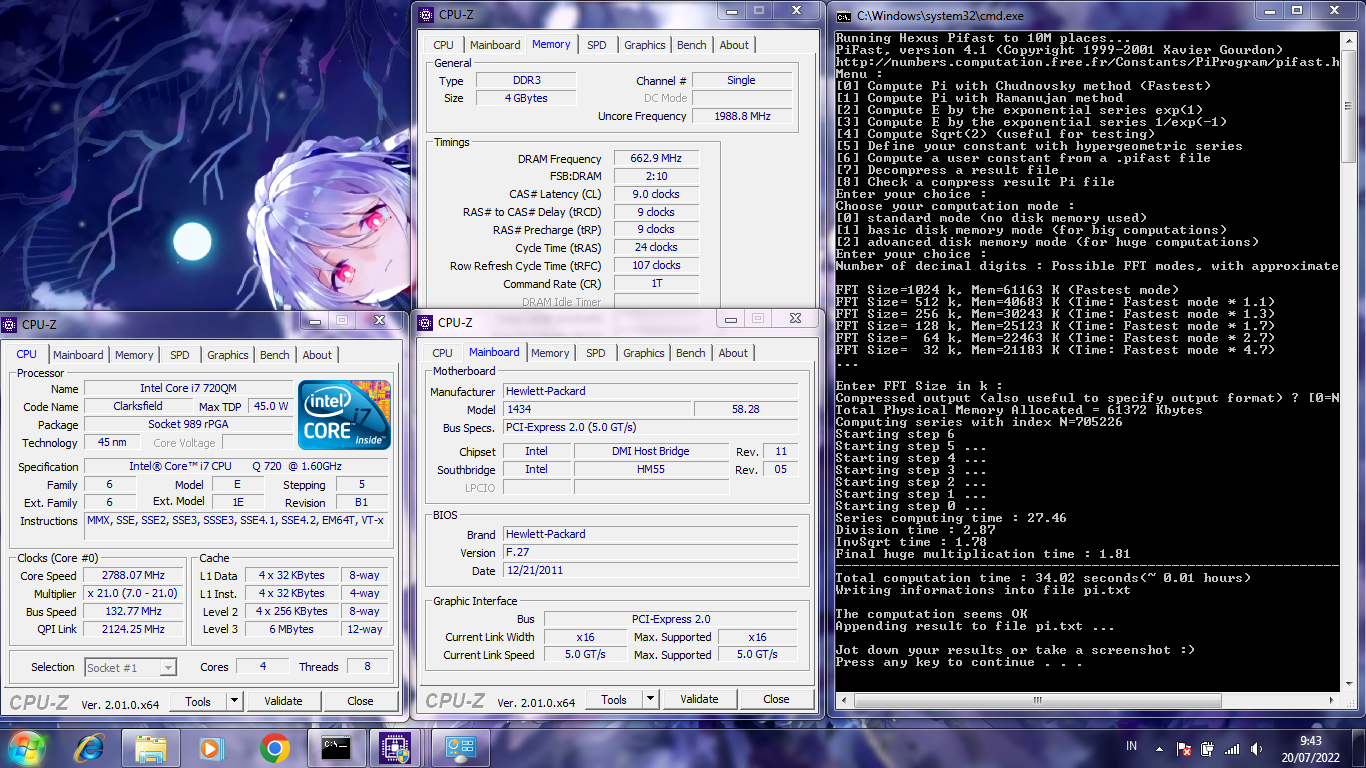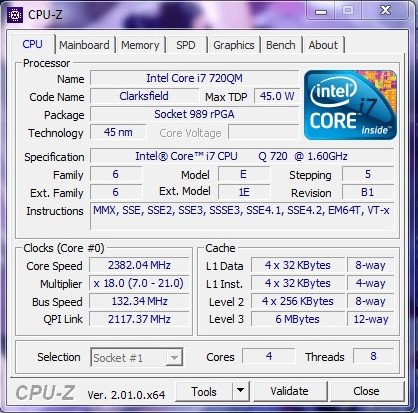PiFast score 34sec 20ms with a i7-720QM
Thursday, 01 January 1970 07:00 | Update at null
Media Gallery
Screenshot

Device, Setup, etc



URL
https://hwbot.org/submission/5044485-
Information Detail
Hardware: Intel Core i7 720QM
Specs:CPUID : Intel(R) Core(TM) i7 CPU Q 720 @ 1.60GHz
Architecture : x86
Codename : Clarksfield
L3 Cache : 6MB
Clock : 1.60GHz - 2.80GHz
Core/Thread : 4/8
TDP : 45W
Technology : 45nm
Socket : PGA988
IGPU : -
See more specification...
Software: PiFast
Score: 34sec 20ms
About: PiFastPiFast is a classic benchmark application designed to measure processor performance in performing intensive mathematical calculations, particularly in calculating the value of pi (π) to millions of digits. This benchmark is renowned for being lightweight, fast to run, and highly accurate in reflecting the capabilities of single-thread CPUs, making it a popular choice among overclockers and system performance testers since the early days of processors.
In PiFast testing, the system is tasked with calculating the value of pi using a fast algorithm based on high-precision mathematics. The faster the time achieved, the higher the performance of the tested CPU. Since PiFast runs on a single core (single thread), this benchmark is highly relevant for measuring the efficiency of a single core in both modern and older processors.
Features and Advantages of PiFast:
- Very lightweight and does not require installation.
- Ideal for testing system stability after overclocking.
- Focuses on single-thread performance, an important indicator in gaming and lightweight application performance.
- Provides test results in seconds, suitable for quick and repetitive testing.
- Compatible with various Windows versions, including older systems.
Although it is quite outdated compared to modern benchmarks, PiFast is still used today as a simple and effective testing tool, especially among the overclocking community and hardware enthusiasts who want to validate performance without running heavy benchmarks.
The Intel Core i7-720QM, launched in Q3 2009, was one of the first mobile quad-core processors to feature Intel's Nehalem microarchitecture, specifically the Clarksfield variant. Targeted at high-performance laptops, such as gaming machines and mobile workstations, the i7-720QM brought 4 physical cores and 8 threads to the mobile platform, thanks to Hyper-Threading Technology providing a significant boost in multi-threaded workloads like video editing, 3D rendering, and other professional-grade applications. The processor runs at a base clock speed of 1.6 GHz, but it can dynamically increase up to 2.8 GHz using Intel Turbo Boost, depending on thermal headroom and power availability.
Manufactured using a 45nm process, the i7-720QM has a TDP of 45W, which is quite high by today's mobile CPU standards. This thermal demand necessitated more robust cooling solutions in laptops that featured the chip. Unlike modern CPUs, the i7-720QM does not come with integrated graphics, which means systems based on this processor require a dedicated GPU often from AMD or NVIDIA for graphics processing and display output. As such, it was typically paired with mid-to-high-end discrete graphics cards in its time, making it a solid choice for gaming and multimedia laptops in the late 2000s and early 2010s.
While the Core i7-720QM was a powerhouse during its release, its performance and efficiency are significantly outpaced by modern CPUs built on smaller nodes and with higher IPC (Instructions Per Clock). Nevertheless, legacy laptops using the i7-720QM can still be viable for basic computing tasks like web browsing, document editing, or watching videos especially if paired with an SSD upgrade and increased RAM. Users running Windows 10 on such systems may experience some limitations, but with proper optimization and lightweight software, the CPU can still deliver a usable experience in non-demanding environments.
Hardware Detail:
Device: HP Pavilion dv3-4054TX
RAM: 4GB DDR3 Single Channel
OS: Windows 7, Windows 10
* Not Avaiable
